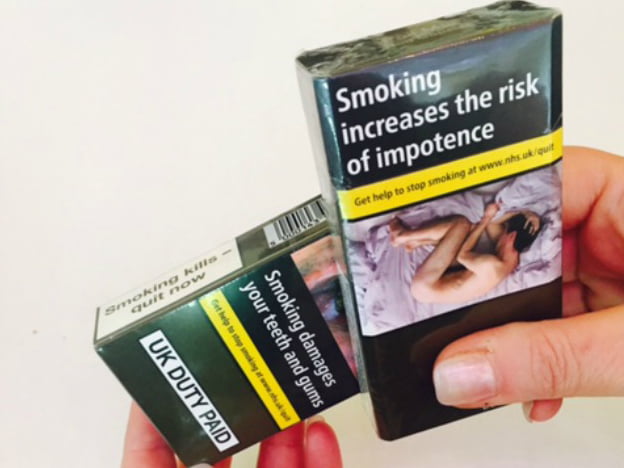Cochrane UK’s Sarah Chapman looks at what new Cochrane evidenceCochrane Reviews are systematic reviews. In systematic reviews we search for and summarize studies that answer a specific research question (e.g. is paracetamol effective and safe for treating back pain?). The studies are identified, assessed, and summarized by using a systematic and predefined approach. They inform recommendations for healthcare and research., published today, can tell us about the health impacts of standardised tobacco packaging (or ‘plain’ packaging), ahead of its full enforcement in the UK next month.
Page checked 30 January 2023
“A brand is a promise. Competition between products is really a competition of ideas and promises.”
If BJ Cunningham, founder of the Enlightened Tobacco Company, is right about this, legislation on standardised packaging for tobacco products, which comes into full effect in the UK on 20 May 2017, should deal a significant blow to the tobacco industry and help cut the number of smokers.
But what do we know about what happens if tobacco brands can’t use unique packaging to sell their ideas and promises? Is image, if not everything, powerful enough to change smoking behaviour if you take it away? A Cochrane ReviewCochrane Reviews are systematic reviews. In systematic reviews we search for and summarize studies that answer a specific research question (e.g. is paracetamol effective and safe for treating back pain?). The studies are identified, assessed, and summarized by using a systematic and predefined approach. They inform recommendations for healthcare and research. published today looks at the evidence behind ‘plain’ packaging.
What is standardised tobacco packaging?
Standardised (or ‘plain’) packaging, as recommended by the World Health Organisation Framework Convention on Tobacco Control, restricts the appearance of tobacco packs with the aim of reducing their appeal. The packs must be uniform in colour, in the appearance of the brand name and, in some cases, shape. They have no logos or branding. In the UK, health warnings are also being enhanced with the introduction of standardised packaging and must cover at least 65% of the packaging.
Australia was the first country to implement standardised tobacco packaging, their legislation taking full effect in December 2012. France implemented standardised packaging by January 2017. Standardised packs started to be introduced in the UK from May 2016 and from 20 May 2017 all tobacco on sale in the UK must comply with the legislation.
The power of packaging
Tobacco packaging is the main source of advertising in countries, like the UK, where other forms of tobacco advertising are prohibited. With most smokers starting before the age of 24, and the majority by age 18, new young smokers are the main target of industry marketing, and building brand awareness amongst young people through packaging has been a key part of the strategy (ASH, 2015). Standardised packaging may make tobacco products less appealing, improve the impact of health warnings and reduce uptake of smoking.
New evidence
A Cochrane Review Tobacco packaging design for reducing tobacco use (published April 2017) brings together the latest, most reliable evidence on the effects of standardised packaging on attitudes to tobacco and on smoking behaviour. The review includes 51 studies involving around 800,000 people. The studies varied in what they did and what was measured. Here’s what they found:
Standardised tobacco packaging may reduce smoking
There is evidence from one large observational studyA study in which the researchers look at what happens over time to groups of people. They study changes or differences in one characteristic (e.g. whether or not people smoke) in relation to changes or differences in another characteristic (e.g. whether or not they get cancer). carried out in Australia, assessing smoking prevalenceThe proportion of a population who have a particular condition or characteristic. For example, the percentage of people in a city with a particular disease, or who smoke. in 700,000 people, that tobacco use may have decreased after the introduction of standardised packaging. Confidence in this finding is limited due to the recency of the introduction of standardised packaging, the difficulty of evaluating populationThe group of people being studied. Populations may be defined by any characteristics e.g. where they live, age group, certain diseases. level policies (where countries cannot be randomisedRandomization is the process of randomly dividing into groups the people taking part in a trial. One group (the intervention group) will be given the intervention being tested (for example a drug, surgery, or exercise) and compared with a group which does not receive the intervention (the control group). to policies) and the difficulty in isolating the effects of a policy when introduced alongside other changes to the pack such as enhanced health warnings, but a reduction in smoking behaviour is supported by dataData is the information collected through research. collected routinely by the Australian government. Australia was the only country to have implemented standardised packaging at the time of the review.
There was no evidence suggesting that standardised tobacco packaging may increase smoking.
Data from a range of other studies to indicate that standardised packaging reduces the appeal may help explain the observed decline in smoking prevalence. No studies directly measured whether plain packs influence starting or stopping smoking.
Professor Ann Mc Neill, from King’s College London and lead author of this Cochrane review, and Deputy Director of the UK Centre for Tobacco and Alcohol Studies, commented:
“Evaluating the impact of standardised packaging on smoking behaviour is difficult to do but the evidence available to us, whilst limited at this time, indicates that standardised packaging may reduce smoking prevalence.” She added, “It would appear that the impact of standardised packaging may be affected by the detail of the regulations such as whether they ban descriptors, such as ‘smooth’ or ‘gold’ and control the shape of the tobacco pack.”
An insider in the tobacco industry told the Observer that companies are finding loopholes in the legislation, such as adding promotional price stickers to cellophane wrappers, or using special finishes on the packs to make them feel more appealing. Might standardised packaging be less plain than intended, and packs still come with promises? According to the whistleblower, “nobody really expects it to work”.
The Cochrane review authors are looking forward to further data on the impact of standardised tobacco packaging becoming available as it is enforced in more countries, including our own. Jamie Hartmann-Boyce, from the Cochrane Tobacco Addiction Group, summed up: “Our evidence suggests that standardised packaging can change attitudes and beliefs about smoking… and may reduce smoking prevalence and increase quit attempts.”
That sounds like an interventionA treatment, procedure or programme of health care that has the potential to change the course of events of a healthcare condition. Examples include a drug, surgery, exercise or counselling. with promise.
Sarah Chapman has nothing to disclose.
References may be found here.


